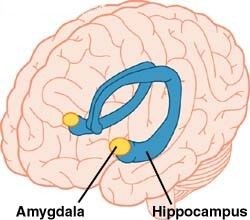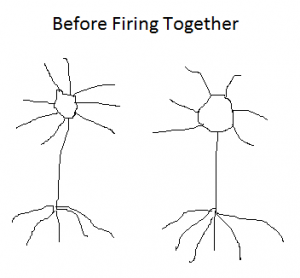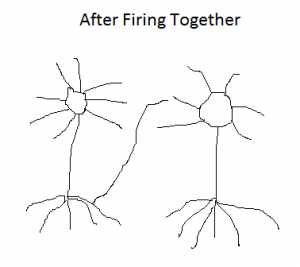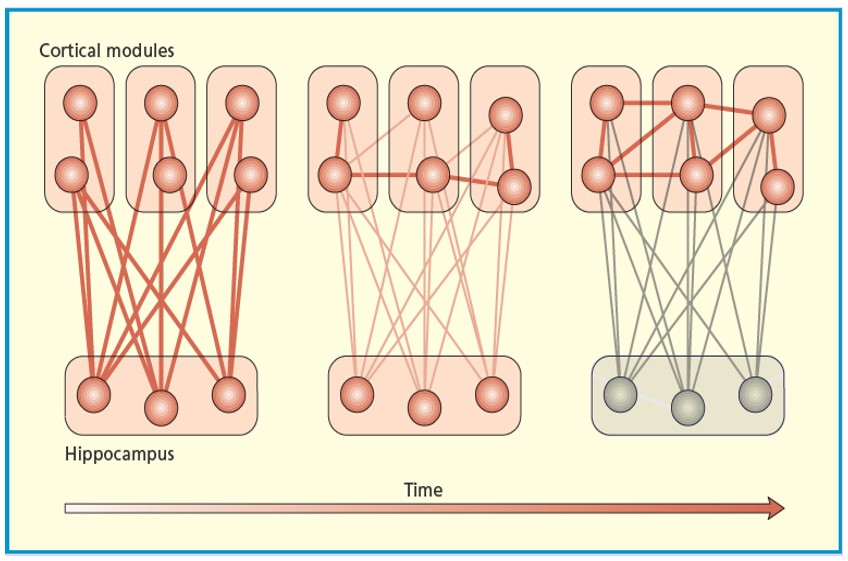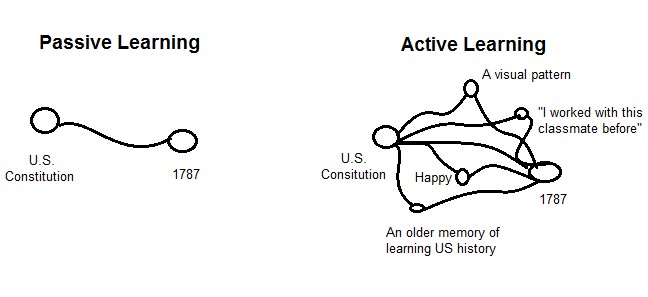Traditional teaching styles typically rely on students learning class material passively, which encompasses listening to lectures and taking notes. However, research examining effective pedagogy tends to support teaching styles that are geared more towards students learning actively (e.g., by engaging students in problem solving; Michel, Cater, & Varela, 2009; Wingfield & Black, 2005).
We can turn to the neuroscience of learning to appreciate why active teaching styles may lead to improved student outcomes. With the advent of neuroimaging techniques in the 1970s and functional imaging in the 1990s (i.e., fMRI), researchers have studied how the brain processes different types of information for several decades. Naturally, scientists have had a great interest in studying learning and memory specifically, and these studies generally show that multimodal or multisensory learning leads to the most long-term physical changes in the brain, and improves memory retention and recall.
A Multisensory Approach to Learning
It appears that learning is enhanced when multiple neural pathways are activated at the same time. In plain terms, the more we can activate students’ brains in different ways, the more they learn. This means that engaging as many sensory, cognitive, emotional and social processes in students will increase their learning potential. This can be accomplished by:
- Making class activities problem-based
- This activates brain regions involved in executive functions (e.g., prefrontal cortex) that aren’t as active when learning passively. Read more about the benefits of problem-based activities here.
- Incorporating short, low-stakes writing assignments
- This introduces tactile stimulation (Mueller & Oppenheimer, 2014), visual processing (through imagination; Shah et al., 2013), and increases activation in prefrontal regions involved in executive function. Read more about this approach here.
- Using varied modes of teaching
- By approaching a topic in multiple ways, students can integrate class content by activating a variety of different interconnected brain processes (e.g., writing, listening, speaking, interacting, moving, etc). Read more about this approach here.
- Asking students to incorporate new knowledge with personal experiences and older knowledge
- This activates older memory pathways and allows new information to be physically linked with them. Read more about this teaching style here.
- Having students work in pairs or groups
- This engages social, emotional, auditory and motor networks. We’ve previously posted about the benefits of peer activities here.
When students work with each other, for example, more cognitive and sensory networks are involved. These processes include talking and listening to others, experiencing positive emotions, moving physically, and problem solving. In comparison, passive learning typically involves less varied activation throughout the brain, in that students sit still and listen. By engaging multiple processes, students learn and retain more information.
Why is Multimodal Activation Important for Learning?
Learning involves physically storing new information- or new connections – in the brain. Therefore, forming new memories requires physical changes to occur between neurons, and this process is aided by the hippocampus. We need our hippocampus for most (but not all) types of learning, and I will explain why a multisensory approach maximizes the work done by this brain region. Many of us have likely heard that the hippocampus ‘does’ memory, but often it is unclear what that means exactly. Some individuals erroneously assume that all of our memories are stored within the hippocampus, but the actual story is much more interesting.
Here is an illustration of where the hippocampi are located (bilaterally):
[image from brainconnection.com]
As you may notice, the hippocampus is centrally located, meaning that it can connect with various cortical regions throughout the brain. Cortical regions are the outside layer of the brain, where all higher order processes take place.
When we learn new information, neurons that code for different aspects of this information begin firing at the same time and “wire together” as a result, physically connecting pieces of older knowledge to create new knowledge. When neurons are firing at the same time, this sends a signal that the two areas (or groups of neurons) are responding to the same information source, and the two areas or clusters should ‘meet’.
Neurons becoming friends after responding to the same stimuli:
But what if these neurons firing at the same time are nowhere near each other? Then we need the help of our hippocampi in order to physically connect these distant neurons. First, the hippocampus connects to the cortical regions that are firing together (e.g., perceptual, linguistic, emotional, etc.). Over time, the hippocampus facilitates a direct connection between the two cortical modules, or clusters of neurons, and the specific memory no longer depends on the hippocampus. The memory is now permanently stored in our cortex, or the outer layer of our brain.
Here is an illustration of how the hippocampus connects different cortical neurons by first binding to them, and then aiding memory storage in the cortex itself (Ward, 2015):
The hippocampus is like a friend introducing two other people who didn’t know each other previously. While the person is needed for the initial introduction, they are no longer needed later on. In this way, memories get permanently stored throughout the brain.
In summary, as more brain areas are activated, there are a higher number of cortical modules the hippocampi have to connect. This, in turn, makes memories more deeply embedded in the brain, and more easily retrievable.
While passive learning may lead to a weak connection between neurons, active multisensory learning leads to deeply embedded neural connections:
References:
Michel, N., Cater, J. J., & Varela, O. (2009). Active versus passive teaching styles: An empirical study of student learning outcomes. Human Resource Development Quarterly, 20(4), 397-418.
Mueller, P. A., & Oppenheimer, D. M. (2014). The Pen Is Mightier Than the Keyboard Advantages of Longhand Over Laptop Note Taking. Psychological science, 0956797614524581
Shah, C., Erhard, K., Ortheil, H. J., Kaza, E., Kessler, C., & Lotze, M. (2013). Neural correlates of creative writing: an fMRI study. Human brain mapping, 34(5), 1088-1101.
Ward, J. (2015). The student’s guide to cognitive neuroscience. Psychology Press.
Willis, J. (2011). Writing and the Brain: Neuroscience Shows the Pathways to Learning. National Writing Project, 3.
Wingfield, S. S., & Black, G. S. (2005). Active versus passive course designs: The impact on student outcomes. Journal of Education for Business, 81(2), 119-123.


